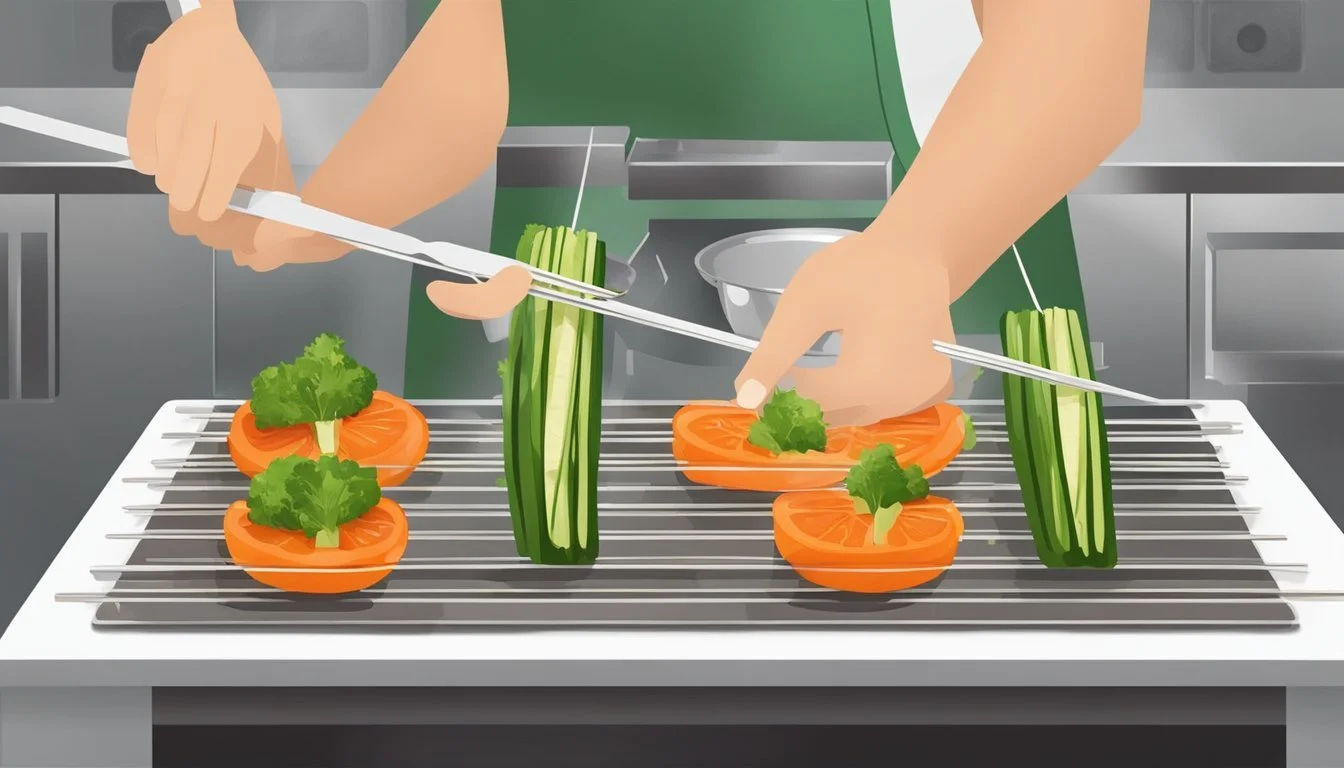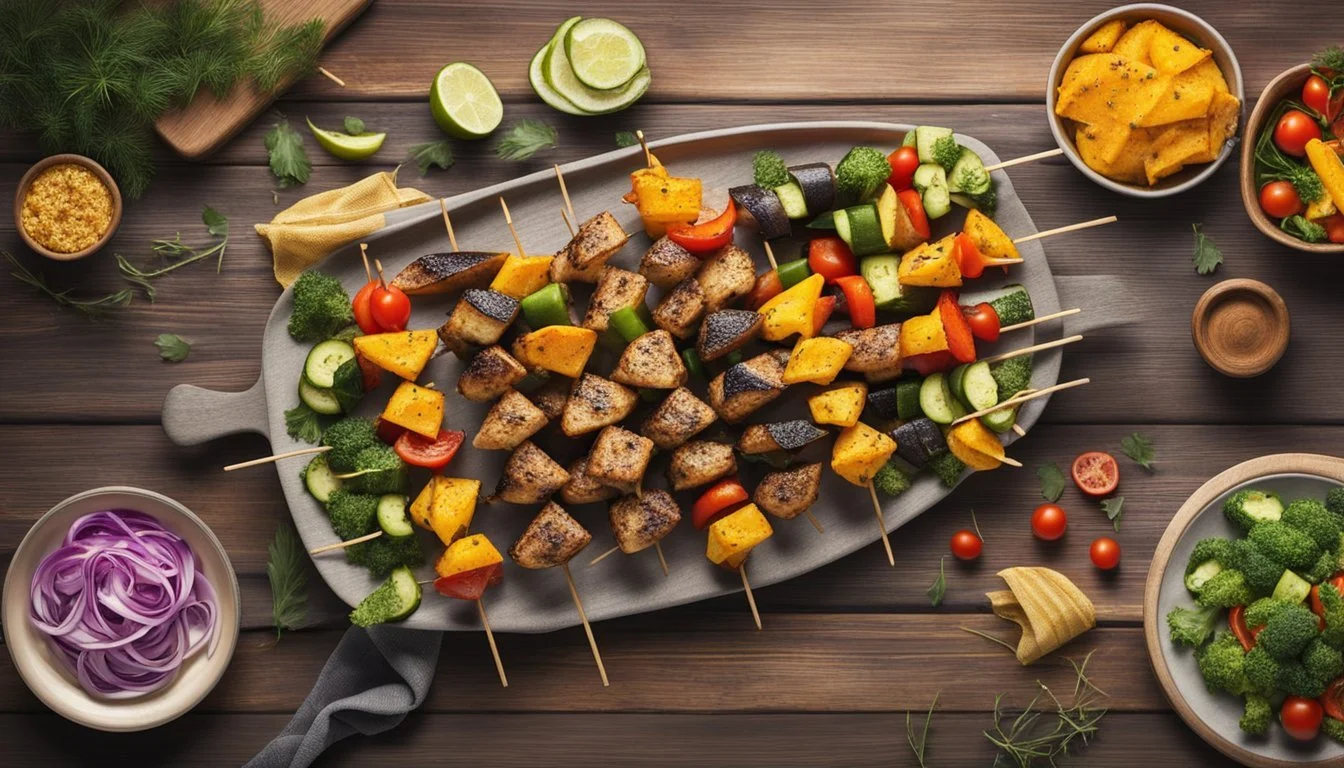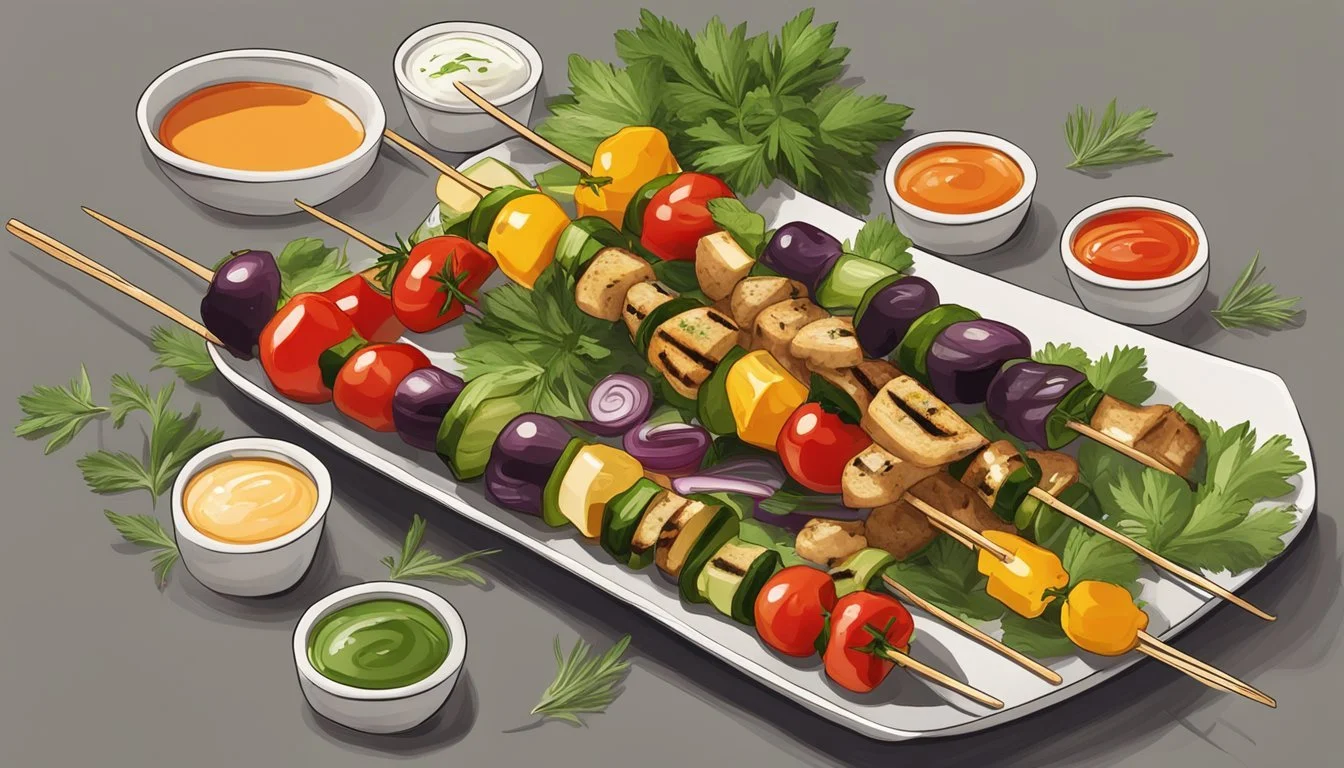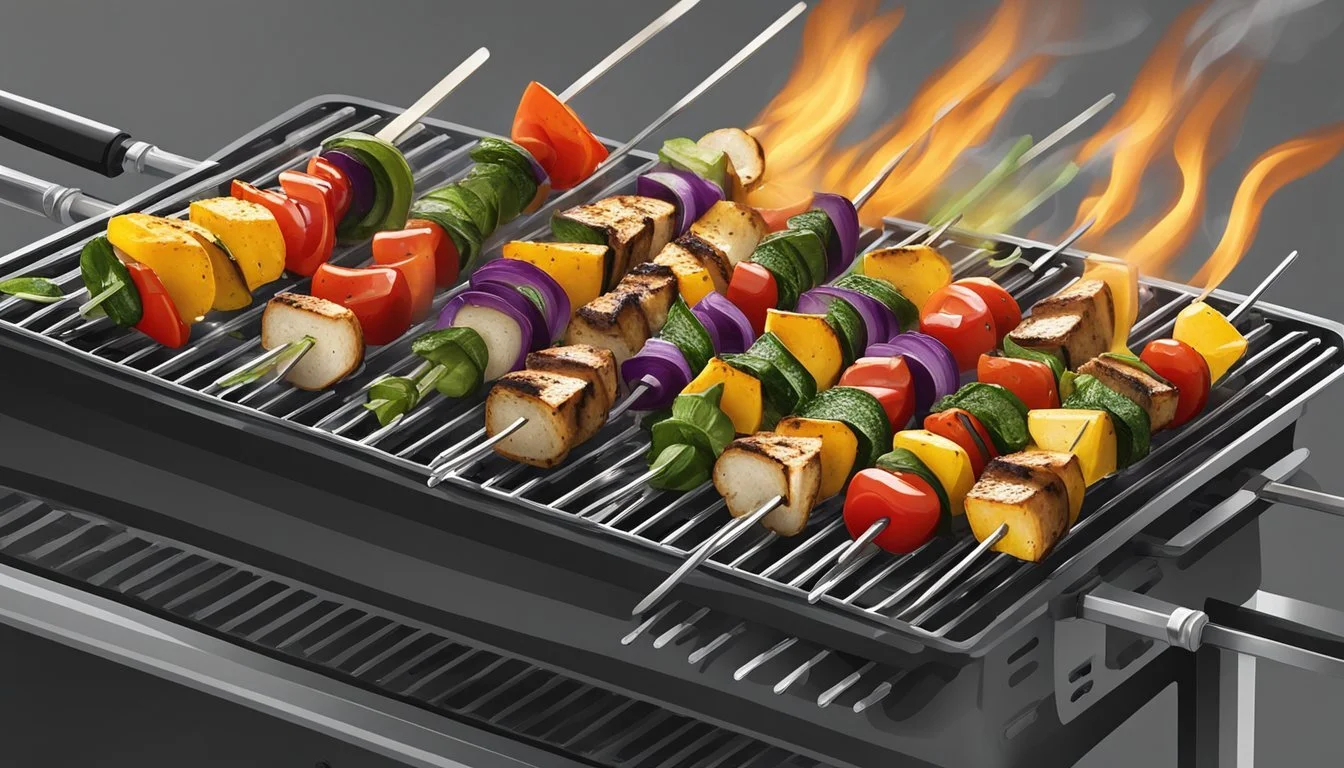How Long Do Gluten-Free Grilled Vegetable Skewers Last?
Storage Tips and Safety
Grilled vegetable skewers make a delicious and convenient gluten-free meal option, perfect for any outdoor gathering or quick dinner. Many home cooks wonder about their shelf life and how best to store them to maintain their freshness and flavor. When stored in an airtight container in the refrigerator, gluten-free grilled vegetable skewers can last for up to 3-5 days. This ensures that you can enjoy your grilled veggies over the span of several meals without worrying about spoilage.
Proper storage is key to preserving the taste and texture of your vegetable skewers. After grilling, allow the skewers to cool to room temperature before placing them in a tightly sealed container. This helps prevent moisture buildup which can lead to mushy vegetables. Reheat them on the stovetop, in a microwave, or using an air fryer to enjoy them warm just like fresh off the grill.
For those who enjoy meal prepping, preparing the skewers and storing them correctly ensures a quick and healthy meal option throughout the week. This can be particularly beneficial for individuals with dietary restrictions, such as gluten intolerance, providing a safe and tasty option that's readily available.
Ingredients and Preparation
In crafting gluten-free grilled vegetable skewers, choosing the right vegetables, preparing them properly, and marinating them effectively are vital steps. Each vegetable adds its distinct flavor and texture to the dish, enhancing the overall taste and presentation.
Selecting Vegetables
Selecting the right mix of vegetables ensures flavorful and visually appealing skewers. Bell peppers, zucchini, onions, mushrooms, and tomatoes are popular choices for their grilling properties and taste.
Summer squash or even small potatoes can also be included. Aim for vegetables that maintain their structure on the grill and do not turn mushy. Freshness is key, so choose vibrant, firm vegetables without blemishes or soft spots.
Organic options are preferred to avoid pesticide residues. For a flavorful twist, consider adding garlic cloves or sprinkling with fresh herbs like oregano or parsley.
Preparing for Grilling
Wash all vegetables thoroughly under cool water. Cut bell peppers into chunks, zucchini into rounds about 1/4 to 3/8 inch thick, and onions into large pieces.
Whole mushrooms and tomatoes can be used as is. Consistent sizing helps in even cooking. After cutting, place the vegetables in a large bowl.
Drizzle generously with olive oil and season with salt and pepper. Olive oil helps prevent sticking and enhances flavor, while salt and pepper bring out the natural tastes. Toss the vegetables to coat evenly before threading them onto skewers.
Marinating the Veggies
Marination adds depth to the grilled vegetables. Combine olive oil, minced garlic, oregano, and a pinch of salt and pepper to create a flavorful marinade. You can include a splash of balsamic vinegar for tanginess.
Pour the marinade over the prepared vegetables and toss to coat. Let the vegetables marinate for at least 30 minutes, up to 24 hours.
Marinating longer allows for better absorption of flavors. Refrigerate the marinated vegetables in an airtight container if preparing ahead. Stir or shake occasionally to ensure all pieces are well-coated before grilling.
Cooking Instructions
Preparing gluten-free grilled vegetable skewers requires a few important steps, including properly skewering the vegetables, grilling them to the right doneness, and considering alternatives to grilling for those without a grill.
Skewering Techniques
To start, select the right skewers. Wooden skewers should be soaked in water for at least 30 minutes to prevent burning. Metal skewers, which don’t require soaking, can be reused and handle high heat better.
Cut vegetables into uniform pieces to ensure even cooking. Ideal vegetables include bell peppers, zucchini, onions, and mushrooms. Skewer the vegetables tightly but leave a little space between them for even heating. Alternate different vegetables to enhance flavor and presentation.
Grilling the Skewers
Preheat the grill to medium heat, around 350°F. Lightly oil the grates to prevent sticking. Place the skewers on the grill and brush them with olive oil or a marinade.
Grill for 7-10 minutes, turning every 2-3 minutes to achieve even grill marks and prevent burning. Vegetables should be tender and lightly charred. Use tongs to handle the hot skewers.
Alternatives to Grilling
For those without a grill, a grill pan or oven can be used. Preheat a grill pan to medium heat and cook the skewers as on a traditional grill. Turn frequently and cook for about 10-15 minutes.
In the oven, preheat to 400°F. Place the skewers on a baking sheet and bake for 10-15 minutes, turning halfway through. Both methods offer a similar result to grilling but may lack the same smoky flavor.
Nutritional Information
Grilled vegetable skewers offer a balanced nutritional profile that can cater to various dietary needs. They are typically low in calories and packed with essential nutrients such as fiber and vitamins.
Macronutrients Profile
Grilled vegetable skewers are an excellent low-calorie option, usually containing 30-50 calories per skewer, depending on the vegetables used.
They are low in carbohydrates, with approximately 5-10 grams per serving, primarily from the vegetables. This carb content is mainly composed of dietary fiber, contributing to 1-3 grams of fiber per skewer.
Protein content in vegetable skewers is relatively low, around 1-2 grams, since vegetables do not typically contain high amounts of protein. However, adding tofu or tempeh can increase this number.
Fat content is minimal, usually under 2 grams, with negligible amounts of saturated fat. For skewers brushed with olive oil, the fat content slightly rises, but it remains healthy due to the monounsaturated fats from the olive oil.
Dietary Considerations
Grilled vegetable skewers are ideal for gluten-free diets. They contain no gluten, provided the marinade and any additional seasonings are free from gluten-containing ingredients.
They are also suitable for low-sodium diets. The sodium content ranges from 5-20 milligrams per skewer, but this can increase if using pre-made marinades or adding salt in the preparation.
High-fiber vegetables like bell peppers, zucchini, and mushrooms boost the fiber content, promoting digestive health.
These skewers are also versatile for various dietary lifestyles, including vegetarian and vegan diets, especially when olive oil and appropriate spices are used. They provide vital nutrients without the negative impact of high-calorie or high-fat content, making them an excellent option for health-conscious individuals.
Tables:
Nutrient Amount per Skewer Calories 30-50 Carbohydrates 5-10 grams Protein 1-2 grams Fat <2 grams Fiber 1-3 grams Sodium 5-20 milligrams
By incorporating nutrient-rich vegetables and healthy fats, grilled vegetable skewers can be part of a balanced diet, fitting into various dietary needs and preferences.
Serving and Presentation
When serving gluten-free grilled vegetable skewers, attention to presentation and flavor enhancements can elevate the dish. Here are some practical suggestions for serving, dressing, and garnishes.
Serving Suggestions
Gluten-free grilled vegetable skewers work well as a main course or side dish. They can be paired with rice, quinoa, or a fresh salad to complete the meal.
For buffet-style gatherings, consider arranging the skewers on a large platter. This makes them easy for guests to grab and enjoy.
To maintain optimal warmth, cover the skewers with foil when serving outdoors or during extended dinner parties. Using sturdy, heat-resistant serving utensils also helps in handling the skewers more efficiently.
Dressing Options
Adding dressings can enhance the flavors of the grilled vegetable skewers. Popular options include a drizzle of lemon juice or a light vinaigrette to add a fresh, zesty touch.
Tzatziki sauce or hummus makes an excellent complementary dip. These can be served on the side for guests to dip at their discretion.
For additional complexity, try a balsamic glaze or herb-infused olive oil. These choices can bring out the natural flavors of the vegetables without overpowering them.
Garnishes and Finishing Touches
Garnishes can turn simple veggie kabobs into a feast for the eyes. Fresh herbs like parsley, cilantro, or basil can be sprinkled on top to add color and aroma.
Adding a few shavings of Parmesan cheese or crumbles of feta offers a savory depth. Toasted nuts like pine nuts or almonds can provide a delightful crunch.
Consider incorporating lemon wedges or lime slices for a refreshing element. These not only add to the visual appeal but also allow diners to squeeze a bit more citrus over their skewers if they wish.
Storage and Shelf Life
Proper storage is crucial for maintaining the freshness and quality of gluten-free grilled vegetable skewers. Attention to storage techniques, identifying spoilage, and reheating leftovers will help ensure they remain safe to consume.
Proper Storage Techniques
After grilling the vegetable skewers, allow them to cool completely before storing. Use an airtight container to keep the skewers fresh. For short-term storage, place the container in the refrigerator, where the skewers can last for up to 3-5 days. Ensure the container is sealed tightly to prevent moisture loss and to keep the skewers flavorful.
If planning to store for a longer period, the skewers can be frozen. Wrap each skewer in plastic wrap, then place them in a freezer bag. This method helps to avoid freezer burn. The skewers can be frozen for up to 2-3 months. Label the freezer bag with the date so you can keep track of when they were stored.
Identifying Spoilage
It's important to check the skewers regularly for signs of spoilage. Odor is a key indicator. If the skewers emit an unusual or sour smell, they should be discarded. Additionally, examine the vegetables for signs of mold or discoloration. Any slimy texture on the vegetables indicates spoilage and the skewers should not be consumed.
Water buildup in the container can also lead to bacterial growth. Ensure that the skewers remain relatively dry during storage. If you notice excess liquid accumulating, it’s a sign that the food may be spoiling faster and action should be taken to check the condition of the skewers.
Reheating Leftovers
For the best taste and texture, reheat leftover skewers in the oven or on the grill. Preheat the oven or grill to 350°F (175°C). Place the skewers on a baking sheet or directly on the grill and heat for about 10 minutes or until they are warmed through. This method helps maintain the grilled flavor and prevents the skewers from becoming soggy.
If using a microwave, place the skewers on a microwave-safe plate and cover them with a damp paper towel. Heat in 30-second intervals until warm. This method is quicker but might not retain the texture as well as grilling or baking. Always ensure the skewers are heated thoroughly before serving.
Pairings and Occasions
Gluten-free grilled vegetable skewers, with their vibrant colors and rich flavors, can be paired with various dishes and suit many occasions.
Complementary Dishes
These skewers pair well with a range of dishes. BBQ favorites like burgers and chicken are perfect companions, balancing the smoky flavors of the grill. For a more plant-based menu, rice and quinoa are excellent choices, providing a hearty, nutritious base for the meal.
Adding potato salad or coleslaw brings a cooling, creamy element that contrasts delightfully with the grilled vegetables' crispness.
Seasonal Pairings
During summer, these skewers shine best at outdoor gatherings such as BBQs or picnics. Pair them with fresh corn on the cob, watermelon slices, and lemonade to enhance the seasonal vibe.
In cooler months, complement the skewers with warm sides like roasted root vegetables or a butternut squash soup for a cozy, comforting meal. Adjust the pairings to match the season, making the most of fresh, in-season produce for vibrant and nutritious meals.
Special Diets and Allergies
When making gluten-free grilled vegetable skewers, it's essential to consider dietary restrictions and allergies. Adaptations for gluten-free, vegan, and vegetarian diets ensure that everyone can enjoy this tasty dish.
Gluten-Free Adaptations
For those who must avoid gluten, selecting the right ingredients is crucial. Opt for gluten-free tamari instead of traditional soy sauce, as soy sauce often contains wheat. Always check labels to confirm that all spices and seasonings are gluten-free.
Cross-contamination is another concern. Use separate utensils and grilling surfaces if preparing both gluten-free and non-gluten-free items. Soaking the skewers in water prevents burning and ensures they’re clean and free from any gluten contamination.
Vegan and Vegetarian Options
To meet vegan and vegetarian needs, choose plant-based ingredients. Vegetables like bell peppers, zucchini, cherry tomatoes, and mushrooms are excellent choices. For added protein, include tofu. Ensure it’s firm or extra firm to hold up well on the grill.
For the marinade, use olive oil, balsamic vinegar, minced garlic, and fresh herbs. Avoid using any animal-based products like honey or dairy. Nutritional yeast can add a cheesy flavor without the dairy.
If accommodating multiple dietary needs, label the skewers clearly to prevent mix-ups. Storing leftovers in an airtight container keeps the skewers fresh for 3-5 days, as long as the ingredients were fresh to start with.
Tips and Tricks
When preparing gluten-free grilled vegetable skewers, paying attention to marinating techniques and choosing the right skewers can significantly enhance the flavor and longevity of the skewers.
Improving Flavor
Marinating the vegetables before grilling boosts both flavor and moisture retention. A simple marinade can be made with olive oil, minced garlic, parsley, cilantro, rosemary, salt, and pepper. This mixture should coat the vegetables evenly, allowing them to soak for up to 24 hours for optimal taste.
Using a mix of vegetables like red onion, zucchini, and bell peppers adds variety. Ensuring each piece is cut to the same size helps with even cooking. Basting the skewers with olive oil while grilling prevents them from drying out and enhances the overall flavor profile.
Skewer Selection and Use
Choosing the right skewers is crucial. Bamboo skewers need to be soaked in water for at least 30 minutes before use to prevent burning. Metal skewers are reusable and heat evenly, providing a consistent cook.
When threading vegetables, leave a small gap between each piece to ensure even heat distribution. Alternating between vegetable types can not only improve taste but also assist in cooking each piece properly. Cook skewers on a preheated grill at medium heat, turning every few minutes for even grilling. Grilled veggie kabobs typically cook for 8-10 minutes, depending on the vegetables used, ensuring a firm yet tender texture.
Cooking Time and Temperatures
Achieving the perfect gluten-free grilled vegetable skewers relies on precise preparation and cooking times and temperatures. Key details include how to get the vegetables ready and how long to grill them for optimal texture and flavor.
Preparation Time
Preparing gluten-free vegetable skewers involves selecting and cutting various vegetables. Bell peppers, onions, zucchini, mushrooms, and tomatoes are common choices.
Chop the bell peppers and onions into large chunks. Slice zucchini into rounds about 1/4-inch thick. All vegetables should then be skewered onto metal or soaked wooden skewers.
Toss the cut vegetables with olive oil and your desired spices. Preparing the vegetables and threading them onto skewers typically takes about 15-20 minutes.
While preparation varies slightly with different vegetables, this time frame is a good baseline for most gluten-free grilled veggie skewers.
Grilling Time
Grilling the skewers demands attention to temperature and timing. Preheat the grill to medium heat (around 350°F). Once preheated, place the skewers on the grill grates.
Cook for approximately 7-8 minutes with the grill cover closed. Open the grill and flip the skewers using tongs; grill for another 7-8 minutes.
Maintain consistent heat to ensure all vegetables cook evenly. Aim to grill until the vegetables are tender and have a slight char.
Total grilling time should be about 14-16 minutes. This timing helps balance a well-cooked interior with a slight, flavorful char on the outside.
Additional Information
The storage of gluten-free grilled vegetable skewers can be influenced by several factors including regional ingredients and conversion measurements between different types of salts and spices.
Regional Variations
Regional cuisine can affect both the preparation and storage of gluten-free grilled vegetable skewers.
For example, Mediterranean recipes might use olive oil, sea salt, and a variety of herbs, while Asian-inspired skewers could include soy sauce (gluten-free), sesame oil, and ground black pepper.
In Europe, ingredients like kosher salt and thyme may be more common, impacting how long the skewers remain fresh.
Storage practices might also vary; in warmer climates, refrigeration times may be shorter compared to cooler regions where the same dish might last longer.
Conversion Tables
Understanding spice and salt conversions is crucial when preparing gluten-free grilled vegetable skewers, especially as it affects taste and preservation.
Common Conversions:
1 teaspoon sea salt = 1 1/4 teaspoons kosher salt
1 teaspoon ground black pepper = 1 1/2 teaspoons whole black peppercorns
Weight Conversions:
1 ounce = approximately 28 grams
1 pound = about 450 grams
Keeping these conversions in mind helps maintain flavor balance and affects how long the skewers can be stored safely. Using too much salt, for example, can make the skewers last longer but may impact taste negatively.











